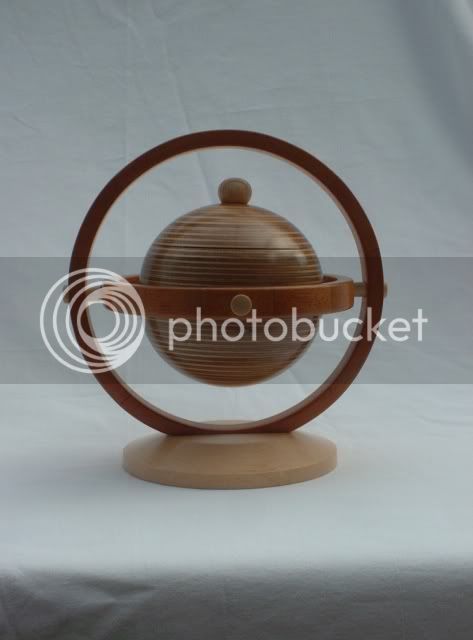I've been given about half a sheet of very good quality 1" beech faced ply, so I thought that I would try segmented turning. I cut it into 9" strips & then into octagons before gluing 4 of them together rotating each one a few degrees.
Stupidly I forgot to take photos at the beginning.
The initial cutting and gluing worked out excellently, but it was just that bit tricky mounting it to be true in each dimension (vertical/horizontal/plumb)
I am also finding it difficult to get any type of even finish. I realise that I am turning against grain in every different direction as well as layers of PVA all at the same time & its a right bugger. I gave up on HSS chisels once it was roughed out & purloined the carbide tipped ones that belong to the mrs. The plywood just trashed the edge of the HSS tools too quickly.
The timber appears pitted, but not evenly. I know why as when I am working with the grain the cutter cuts easier than the neighbouring "end grain".
I am also finding that even though the ply is good quality, there are still empty voids where the timber layers dont quite meet. I don't like the idea of twin pack filler , but I don't seem to have much choice.
Another mistake in my initial construction is that I found that with a depth of 4" (aiming at 3" deep inside), I am finding it difficult to hollow out as I do not own a bowl rest. Maybe I will cut 1" off the bottom to make it easier on the 1st attempt
So just a couple of questions here:
Am I missing a trick turning with/against the grain/PVA and how anyone else is overcoming this problem.
What technique is being used to create an overall flat finish as sanding the surface only seems to increase the peaks and pits.
How about filling the voids? Is there a product that gives a decent finish. How about a clear epoxy compound?
(I have glued another 3 ply layers together so will look at adding those photos and also current progress over the next few days) )
Stupidly I forgot to take photos at the beginning.
The initial cutting and gluing worked out excellently, but it was just that bit tricky mounting it to be true in each dimension (vertical/horizontal/plumb)
I am also finding it difficult to get any type of even finish. I realise that I am turning against grain in every different direction as well as layers of PVA all at the same time & its a right bugger. I gave up on HSS chisels once it was roughed out & purloined the carbide tipped ones that belong to the mrs. The plywood just trashed the edge of the HSS tools too quickly.
The timber appears pitted, but not evenly. I know why as when I am working with the grain the cutter cuts easier than the neighbouring "end grain".
I am also finding that even though the ply is good quality, there are still empty voids where the timber layers dont quite meet. I don't like the idea of twin pack filler , but I don't seem to have much choice.
Another mistake in my initial construction is that I found that with a depth of 4" (aiming at 3" deep inside), I am finding it difficult to hollow out as I do not own a bowl rest. Maybe I will cut 1" off the bottom to make it easier on the 1st attempt
So just a couple of questions here:
Am I missing a trick turning with/against the grain/PVA and how anyone else is overcoming this problem.
What technique is being used to create an overall flat finish as sanding the surface only seems to increase the peaks and pits.
How about filling the voids? Is there a product that gives a decent finish. How about a clear epoxy compound?
(I have glued another 3 ply layers together so will look at adding those photos and also current progress over the next few days) )


































